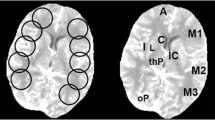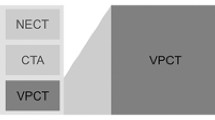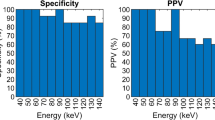Abstract
Purpose
To evaluate image quality and diagnostic accuracy for acute infarct detection and radiation dose of 70 kVp whole brain CT perfusion (CTP) and CT angiography (CTA) reconstructed from CTP source data.
Methods
Patients were divided into three groups (n = 50 each): group A, 80 kVp, 21 scanning time points; groups B, 70 kVp, 21 scanning time points; group C, 70 kVp, 17 scanning time points. Objective and subjective image quality of CTP and CTA were compared. Diagnostic accuracy for detecting acute infarct and cerebral artery stenosis ≥ 50 % was calculated for CTP and CTA with diffusion weighted imaging and digital subtraction angiography as reference standards. Effective radiation dose was compared.
Results
There were no differences in any perfusion parameter value between three groups (P > 0.05). No difference was found in subjective image quality between three groups (P > 0.05). Diagnostic accuracy for detecting acute infarct and vascular stenosis showed no difference between three groups (P > 0.05). Compared with group A, radiation doses of groups B and C were decreased by 28 % and 37 % (both P < 0.001), respectively.
Conclusion
Compared with 80 kVp protocol, 70 kVp brain CTP allows comparable vascular and perfusion assessment and lower radiation dose while maintaining high diagnostic accuracy in detecting acute infarct.
Key Points
• 70 kVp whole brain CTP can provide diagnostic image quality.
• 70 kVp CTP diagnostic accuracy was maintained vs. 80 kVp protocol.
• 70 kVp CTP radiation doses were lower than 80 kVp protocol.




Similar content being viewed by others
References
Aviv RI, d'Esterre CD, Murphy BD et al (2009) Hemorrhagic transformation of ischemic stroke: prediction with CT perfusion. Radiology 250:867–877
Hoang JK, Wang C, Frush DP et al (2013) Estimation of radiation exposure for brain perfusion CT: standard protocol compared with deviations in protocol. AJR Am J Roentgenol 201:W730–W734
Ringelstein A, Lechel U, Fahrendorf DM et al (2014) Radiation exposure in perfusion CT of the brain. J Comput Assist Tomogr 38:25–28
Li ZL, Li H, Zhang K et al (2014) Improvement of image quality and radiation dose of CT perfusion of the brain by means of low-tube voltage (70 KV). Eur Radiol 24:1906–1913
Corcuera-Solano I, McLellan AM, Doshi AH et al (2014) Whole-brain adaptive 70-kVp perfusion imaging with variable and extended sampling improves quality and consistency while reducing dose. AJNR Am J Neuroradiol 35:2045–2051
Luo S, Zhang LJ, Meinel FG et al (2014) Low tube voltage and low contrast material volume cerebral CT angiography. Eur Radiol 24:1677–1685
Cho ES, Chung TS, Oh DK et al (2012) Cerebral computed tomography angiography using a low tube voltage (80 kVp) and a moderate concentration of iodine contrast material: a quantitative and qualitative comparison with conventional computed tomography angiography. Invest Radiol 47:142–147
Lin CJ, Wu TH, Lin CH et al (2013) Can iterative reconstruction improve imaging quality for lower radiation CT perfusion? Initial experience. AJNR Am J Neuroradiol 34:1516–1521
Abels B, Klotz E, Tomandl BF et al (2010) Perfusion CT in acute ischemic stroke: a qualitative and quantitative comparison of deconvolution and maximum slope approach. AJNR Am J Neuroradiol 31:1690–1698
Abels B, Klotz E, Tomandl BF et al (2011) CT perfusion in acute ischemic stroke: a comparison of 2-second and 1-second temporal resolution. AJNR Am J Neuroradiol 32:1632–1639
Chen GZ, Zhang LJ, Schoepf UJ et al (2015) Radiation dose and image quality of 70 kVp cerebral CT angiography with optimized sinogram-affirmed iterative reconstruction: comparison with 120 kVp cerebral CT angiography. Eur Radiol 25:1453–1463
Haubenreisser H, Fink C, Nance JW Jr et al (2015) Feasibility of slice width reduction for spiral cranial computed tomography using iterative image reconstruction. Eur J Radiol 83:964–969
Saake M, Goelitz P, Struffert T et al (2012) Comparison of conventional CTA and volume perfusion CTA in evaluation of cerebral arterial vasculature in acute stroke. AJNR Am J Neuroradiol 33:2068–2073
Suzuki K, Morita S, Masukawa A et al (2011) Utility of CT perfusion with 64-row multi-detector CT for acute ischemic brain stroke. Emerg Radiol 18:95–101
Hoeffner EG, Case I, Jain R et al (2004) Cerebral perfusion CT: technique and clinical applications. Radiology 231:632–644
Nabavi DG, Cenic A, Craen RA et al (1999) CT assessment of cerebral perfusion: experimental validation and initial clinical experience. Radiology 213:141–149
Bogartz G. Golding SJ, Jurik AG et al (2004) European Guidelines for Multislice Computed Tomography. http://w3.tue.nl/fileadmin/sbd/Documenten/Leergang/BSM/European_Guidelines_Quality_Criteria_Computed_Tomography_Eur_16252.pdf Accessed 19 Feb 2014
Cohen J (1960) A coefficient of agreement for nominal scales. Educ Psychol Meas 20:37–46
Funama Y, Awai K, Nakayama Y et al (2005) Radiation dose reduction without degradation of low-contrast detectability at abdominal multisection CT with a low-tube voltage technique: phantom study. Radiology 237:905–910
Yamamura S, Oda S, Imuta M et al (2015) Reducing the radiation dose for CT colonography: effect of low tube voltage and iterative reconstruction. Acad Radiol S1076–6332(15):00130
Zhang LJ, Wang Y, Schoepf UJ (2015) Image quality, radiation dose, and diagnostic accuracy of prospectively ECG-triggered high-pitch coronary CT angiography at 70 kVp in a clinical setting: comparison with invasive coronary angiography. Eur Radiol. doi:10.1007/s00330-015-3868-z
Cho ES, Chung TS, Ahn SJ (2015) Cerebral computed tomography angiography using a 70 kVp protocol: improved vascular enhancement with a reduced volume of contrast medium and radiation dose. Eur Radiol 25:1421–1430
Durand S, Paul JF (2014) Comparison of image quality between 70 kVp and 80 kVp: application to paediatric cardiac CT. Eur Radiol 24:3003–3009
Zhang LJ, Qi L, Wang J (2014) Feasibility of prospectively ECG-triggered high-pitch coronary CT angiography with 30 mL iodinated contrast agent at 70 kVp: initial experience. Eur Radiol 24:1537–1546
Kloska SP, Fischer T, Sauerland C et al (2010) Increasing sampling interval in cerebral perfusion CT: limitation for the maximum slope model. Acad Radiol 17:61–66
Khatri P, Yeatts SD, Mazighi M et al (2014) Time to angiographic reperfusion and clinical outcome after acute ischaemic stroke: an analysis of data from the Interventional Management of Stroke (IMS III) phase 3 trial. Lancet Neurol 13:567–574
Frölich AM, Psychogios MN, Klotz E et al (2012) Angiographic reconstructions from whole-brain perfusion CT for the detection of large vessel occlusion in acute stroke. Stroke 43:97–102
Ho CY, Hussain S, Alam T et al (2013) Accuracy of CT cerebral perfusion in predicting infarct in the emergency department: lesion characterization on CT perfusion based on commercially available software. Emerg Radiol 20:203–212
Acknowledgments
The scientific guarantor of this publication is Guang Ming Lu. The authors of this manuscript declare relationships with the following companies: UJS is a consultant for and receives research support from Bayer, Bracco, GE, Medrad, and Siemens. The other authors have no conflicts of interest to declare.
This study has received funding by Program for New Century Excellent Talents in University (NCET-12-0260 to L.J.Z.). No complex statistical methods were necessary for this paper. Institutional Review Board approval was obtained. Written informed consent was obtained from all subjects (patients) in this study. No study subjects or cohorts have been previously reported. Methodology: prospective, observational study, performed at one institution.
Author information
Authors and Affiliations
Corresponding authors
Rights and permissions
About this article
Cite this article
Fang, X.K., Ni, Q.Q., Schoepf, U.J. et al. Image quality, radiation dose and diagnostic accuracy of 70 kVp whole brain volumetric CT perfusion imaging: a preliminary study. Eur Radiol 26, 4184–4193 (2016). https://doi.org/10.1007/s00330-016-4225-6
Received:
Revised:
Accepted:
Published:
Issue Date:
DOI: https://doi.org/10.1007/s00330-016-4225-6




